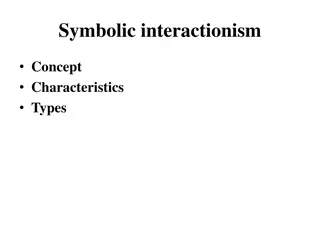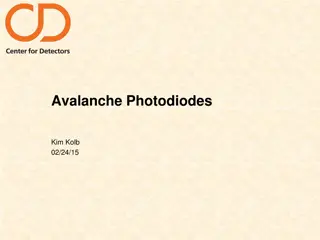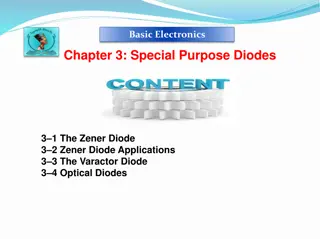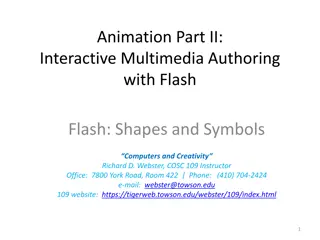Understanding Photodiodes: Operation, Types, and Symbols
A photodiode is a sensitive semiconductor device that converts light into electric current. Operating in reverse bias, it generates charge carriers in the depletion region using external energy sources such as light. Different types include PN junction, PIN, and avalanche photodiodes, each designed for specific applications. The symbol of a photodiode features arrows representing light or photons. Learn about the operation and mechanisms of these essential components in light detection and sensor technologies.
Download Presentation

Please find below an Image/Link to download the presentation.
The content on the website is provided AS IS for your information and personal use only. It may not be sold, licensed, or shared on other websites without obtaining consent from the author. Download presentation by click this link. If you encounter any issues during the download, it is possible that the publisher has removed the file from their server.
E N D
Presentation Transcript
Photodiode A photodiode is a P-N junction or PIN semiconductor device which it is very sensitive to light and easily converts light into electric current. Photodiodes are specially designed to operate in reverse bias condition. It is also sometimes referred as: Light-detector photo-sensor photo-detector In a normal p-n junction diode, voltage is used as the energy source to generate electric current whereas in photodiodes, both voltage and light are used as energy source to generate electric current.
Photodiodesymbol The symbol of photodiode is similar to the normal p-n junction diode except that it contains arrows striking the diode. These arrows represent light or photons. A photodiode has two terminals: a cathode and an anode.
Operationofphotodiode A normal p-n junction diode allows a small amount of electric current under reverse bias condition. The external reverse voltage applied to the p-n junction diode will supply energy to the minority carriers but not increase the population of these carriers. To increase this current, we need to generate more minority carriers. The minority carriers generated at n-side or p-side will recombine in the same material before they cross the junction. As a result, no electric current flows due to these charge carriers. To overcome this problem, we need to apply external energy directly to the depletion region to generate more charge carriers.
Photodiode is specially designed to generate more number of charge carriers in depletion region. In which, light or photons are use as the external energy to generate these charge carriers. Typesofphotodiodes The working operation of all types of photodiodes is same. Different types of photodiodes are developed based on specific application. The different types of photodiodes are : PN junction photodiode PIN photodiode Avalanche photodiode
PNjunctionphotodiode PN junction photodiodes (also simply referred as photodiode) are the first form of photodiodes. They are the most widely used photodiodes before the development of PIN photodiodes.
When external light energy is supplied to the p-n junction photodiode, the valence electrons in the depletion region gains energy. If the light energy is greater than the band-gap of semiconductor material, the valence electrons gain enough energy and break bonding with the parent atom (become free electron). When the valence electron leave the valence shell, an empty space is created which is called a hole. Thus, both free electrons and holes are generated as pairs. The mechanism of generating electron-hole pair by using light energy is known as innerphotoelectriceffect.
The minority carriers in the depletion region experience force due to the depletion region electric field and the external electric field. As a result, free electrons move towards the n-region. When the free electrons reach n-region, they are attracted towards the positive terminals of the battery. In the similar way, holes move in opposite direction. The strong depletion region electric field and the external electric field increase the drift velocity of the free electrons. Because of this high drift velocity, the minority carriers (free electrons and holes) generated in the depletion region will cross the p-n junction before they recombine with atoms. As a result, the minority carrier current increases.
When no light is applied to the reverse bias photodiode, it carries a small reverse current (leakage current) due to external voltage. This small electric current under the absence of light is called darkcurrent. It is denoted by I . The darkcurrent in the photodiode increases when: Temperature increases. The material used to construct the photodiode also affects the dark current. Germanium, Indium Arsenide Antimonide, Indium Gallium Arsenide and Mercury Cadmium Telluride generates large dark current because they are very sensitive to temperature.
In a photodiode, reverse current is independent of reverse bias voltage. It is mostly depends on the light intensity. The electric current generated in the photodiode due to the application of light is called photocurrent. The total current through the photodiode is the sum of the dark current and the photocurrent.
PINphotodiode PIN photodiodes are developed from the PN junction photodiodes. The operation of PIN photodiode is similar to the PN junction photodiode except that the PIN photodiode is manufactured differently to improve its performance. It is developed to increase the minority carrier current and response speed. They generate more electric current than the PN junction photodiodes with the same amount of light energy. PIN photodiode is made of three layers namely p-type, n-type and intrinsic semiconductor. This addition layer (intrinsic semiconductor) is placed between the p-type and n- type semiconductor to increase the width of depletion region (increase the minority carrier current ).
PINphotodiodeoperation A PIN photodiode is made of p-region and n-region separated by a highly resistive intrinsic layer. The p-type and n-type semiconductors are heavily doped. Therefore, they have large number of charge carriers to carry electric current. However, these charge carriers will not carry electric current under reverse bias condition because the width of depletion region becomes very wide. On the other hand, intrinsic semiconductor is an undoped semiconductor material. Therefore, this region does not have charge carriers to conduct electric current.
In PIN photodiode, the charge carriers generated in the depletion region carry most of the electric current. Therefore, increasing the width of depletion region increases the minority carrier electric current. When light or photon energy is applied to the PIN diode, most part of the energy is observed by the intrinsic or depletion region because of the wide depletion width. As a result, a large number of electron-hole pairs are generated. Free electrons generated in the intrinsic region move towards n- side whereas holes generated in the intrinsic region move towards p-side. The free electrons and holes moved from one region to another carry electric current. When free electrons and holes reach n- region and p-region, they are attracted to towards the positive and negative terminals of the battery.
The population of minority carriers in PIN photodiode is very large compared to the PN junction photodiode. Therefore, PIN photodiode carry large minority carrier current than PN junction photodiode. The capacitance is directly proportional to the size of electrodes and inversely proportional to the distance between electrodes. In PIN photodiode, the p-region and n-region acts as electrodes and intrinsic region acts as dielectric. The separation distance between p-region and n-region in PIN photodiode is very large because of the wide depletion width. Therefore, PIN photodiode has low capacitance compared to the PN junction photodiode.
AdvantagesofPINphotodiode 1. Wide bandwidth 2. High quantum efficiency 3. High response speed
Avalanchephotodiode The operation of avalanche photodiode is similar to the PN junction and PIN photodiode except that , in case of avalanche photodiode, a high reverse bias voltage is applied to achieve avalanche multiplication. When light energy is applied to the avalanche photodiode, electron-hole pairs are generated in the depletion region. By applying a very high reverse bias voltage, large amount of energy absorbed by the minority carriers (electron-hole pairs), which are accelerated to greater velocities. When the free electrons moving at high speed collides with the atom, they knock off more free electrons. The newly generated free electrons are again accelerated and collide with other atoms.
Because of this continuous collision with atoms, a large number of minority carriers are generated. Thus, avalanche photodiodes generates more number of charge carriers than PN and PIN photodiodes. Advantagesofavalanchephotodiode 1- High sensitivity 2- Larger gain Disadvantagesofavalanchephotodiode Generates high level of noise than a PN photodiode
Photodiodeoperationmodes A photodiode can be operated in one of these two modes: 1- photovoltaicmode 2- photoconductivemode Operation mode selection of the photodiode is depends upon the: 1- speed requirements of the application. 2- the amount of dark current that is tolerable.
Photovoltaicmode In the photovoltaic mode, the photodiode is unbiased (no external voltage is applied to the photodiode) and dark current is very low. Also, Photodiodes operated in photovoltaic mode have low response speed and are generally used for low speed applications or for detecting low light levels. Photoconductivemode In photoconductive mode, an external reverse bias voltage is applied to the photodiode. Applying a reverse bias voltage increases the width of depletion region and reduces the junction capacitance which results in increased response speed. The reverse bias also increases the dark current. Photodiodes operated in photoconductive mode has high noise current. This is due to the reverse saturation current flowing through the photodiode.
Performanceparametersofaphotodiode Responsivity: is the ratio of generated photocurrent to the incident light power. Quantum efficiency: is defined as the ratio of the number of electron-hole pairs generated to the incident photons. Response time or transit time: is defined as the time it takes for light generated charge carriers to cross p-n junction.
Photodiodeapplications The various applications of photodiodes are : 1. Compact disc players 2. Smoke detectors 3. Space applications 4. Medical applications such as pulse oximeters. 5. Optical communications. 6. Measuring extremely low light intensities.
Varactor diode Varactor diodeis a p-n junction which operates only in reverse bias, its capacitance is varied by varying the reverse voltage. The term varactor is originated from a variable capacitor. It is also sometimes referred to as varicapdiode, tuningdiode, or variable capacitance diode. The varactor diode is manufactured in such as way that it shows better transition capacitance property than the ordinary diodes.
Varactor diode symbol The symbol of the varactor diode is almost similar to the normal p-n junction diode. Two parallel lines at the cathode side represents two conductive plates and the space between these two parallel lines represents dielectric
Unbiased varactor diode In the n-type semiconductor, a large number of free electrons are present and in the p-type semiconductor, a large number of holes are present. The free electrons and holes always try to move from a higher concentration region to a lower concentration region. Therefore, the free electrons always try to move from n-region to p-region similarly holes always try to move from p- region to n-region. When the free electrons reach p-n junction, they experience an attractive force from the holes in the p-region. As a result, the free electrons cross the p-n junction. In the similar way, holes also cross the p-n junction. Because of the flow of these charge carriers, a tiny current flows across diode for some period.
During this process, some neutral atoms near the junction at n-side lose electrons and become positively charged atoms (positive ions) similarly some neutral atoms near the junction at p-side gains extra electrons and become negatively charged atoms (negative ions). These positive and negative ions created at the p-n junction create the depletion region. This depletion region prevents further current flow across the p-n junction. The width of depletion region depends on the number of impurities added (amount of doping). A heavily doped varactor diode has a thin depletion layer whereas a lightly doped varactor diode has a wide depletion layer.
We know that an insulator or a dielectric does not allow electric current through it. The depletion region also does not allow electric current through it. So the depletion region acts like a dielectric of a capacitor. The electrodes or conductive plates easily allow electric current through them. The p-type and n-type semiconductor also easily allow electric current through them. So the p-type and n-type semiconductor acts like the electrodes or conductive plates of the capacitor. Thus, varactor diode behaves like a normal capacitor. In an unbiased varactor diode, the depletion width is small. So the capacitance (charge storage) is very large.
Operation of varactor diode The varactor diode should always be operated in reverse bias. (A varactor diode is designed to store electric charge not to conduct electric current).
When a reverse bias voltage is applied, the electrons from n-region and holes from p-region move away from the junction. As a result, the width of depletion region increases and the capacitance decreases. However, if the applied reverse bias voltage is very low the capacitance will be very large.
So the reverse bias voltage should be kept at a minimum to achieve large storage charge. Thus, capacitance or transition capacitance can be varied by varying the voltage. Applications of varactor diode 1- Varactor diode is used in frequency multipliers. 2- Varactor diode is used in parametric amplifiers. 3- Varactor diode is used in voltage-controlled oscillators























